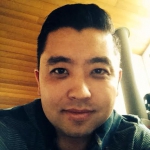For my entire '80s-soaked childhood, my one onscreen role model was Vietnam-born Jonathan Ke Quan, the actor who played the ultra-stereotypical
(“NOT VELLY FUNNY, DOCTAH JONES!”) Short Round in Indiana Jones and the Temple of Doom and tech nerd Data in The Goonies. I wanted to be Data so badly
-- he was the only “cool” Asian I’d seen portrayed in mainstream American film.
But by the time I hit puberty, I no longer wanted to mimic an immigrant Asian –
I craved people who looked like me onscreen. Then The Joy Luck Club came along.
Wayne Wang’s film adaptation of The Joy Luck Club was released in 1993. This was the first “mainstream,” Hollywood-financed feature film to feature a cast made up (almost) entirely of Asian American actors. Even at the tender age of 13, I remember being drawn into the film. My mom had
read the novel, so she brought me with her to watch it. I’ve always been a
crier when it comes to films, and I found
myself sobbing at several points during The Joy
Luck Club. While this was a film about
women, mothers and daughters, the story still struck me in how unflinchingly it portrayed wide generational divides and racial glass ceilings. Aside from the
phenotype of the actors, though, there wasn’t a lot of “me” on the screen.
The Joy Luck Club turned 20 last year, and time -- as well as the long critical view -- has not been kind. Critics claim that the film reduces its characters to one
or two notes, reinforcing negative stereotypes about Asian men,
women, and children. And though many film critics at the time lauded Joy Luck for of its “authentic” casting,
that, too, is more problematic now. In revisiting this film as adult, I was struck
by two specific elements: the prevalence of monolithic Asian casting, and the
presentation of the male characters in the film.
When the
film was made, actors with a variety of Asian American backgrounds had parts. However, the story is about four pairs of Chinese immigrant mothers and their
American-born daughters. The first featured pair is June Woo and her mother,
Suyuan. In the film, June is played by Ming-Na Wen, seen currently on TV in Agents of S.H.I.E.L.D. Wen is Chinese American,
and thus appropriately cast in the role. Her mother, though, is played by actor
Kieu Chinh, who is of Vietnamese descent. Lena St. Clair and her mother,
Ying-Ying, are portrayed by Chinese American actor Lauren Tom and French-Vietnamese
actor France Nuyen, respectively. Waverly, June’s
longstanding rival, is played by Japanese American Tamlyn Tomita.
The casting
of Nuyen, Chinh, and Tomita is, on the surface, not that big of a deal -- but it set a lazy standard for casting Asian roles, a standard that continues to this day. Memoirs of a Geisha, for
example, distractingly featured Chinese women in the main roles, despite the
fact that the film takes place entirely in Japan. This brand of “colorblind”
casting isn’t new, and it would be hard to argue that it could or should be eliminated
altogether -- if a role is broad enough to be played by anyone, race and
ethnicity shouldn’t matter. But if you’re attempting to portray an individual from a specific,
underrepresented culture, then there should be at least a modicum of effort to
do that authentically.
Then
there’s the way that Asian men are portrayed in the film. In this film, three
of the daughters -– Lena, Waverly, and Rose (played by Rosalind Chao) -– all
experience hardships in their relationships, with the Asian husbands coming off
as bastards. Waverly’s first husband, who is Asian, is never even shown;
instead, we are treated to her white second husband, a goofy, walking micro-aggression
who pours soy sauce all over Waverly’s mother’s cooking. He makes no effort to
understand Waverly’s culture, yet is the one who “fixes” Waverly’s broken
relationship with her mother. Rose’s husband, played by Andrew McCarthy, is
shown disapproving of his Chinese wife’s stoicism and eagerness to please, leading him to cheat on her. In both cases, Asian American women are shown as willing to sacrifice in order to marry
into white society.
The only Asian husband that is given meaningful screen time
is Lena’s husband, Harold, played by actor Michael Paul Chan. Sadly, he’s the
walking embodiment of the emasculated Asian male. He’s meek and miserly; he has
no desires or ambitions; he rejects his wife’s existence almost entirely. When Lena finally stands up to him, he simply
vanishes from the film, a ghost that, for all intents and purposes, never
existed. He’s replaced in her life by a masculine, Western-looking Asian dude who never
speaks on screen.
This film might have been different had it been made from a perspective more sympathetic to women -- ideally by
an Asian American woman. Though Wang, the film's director, is Asian, he makes
little effort to move beyond a surface view of the women in this film. Waverly and June remain bitter rivals, doomed to be proxy chess pieces for their mothers. Rose and Lena are shown as meek and in need of saving from men who show them their true selves -- which they are incapable of finding on their own. Women initially written to be somewhat more complex and nuanced are
depicted as objects of desire, victims of abuse, or both.
Twenty
years after its premiere, The Joy Luck
Club remains a landmark film for Asian Americans. Something was finally on screen for us, and regardless of quality, that did and does matter. Examining the film's legacy now, it can't help but disappoint. Like many of us, I am still waiting for the great Asian American film. I
know it’s out there. But it’s not The
Joy Luck Club.










Comments